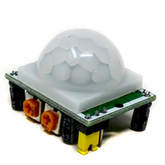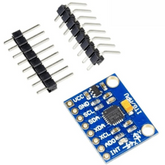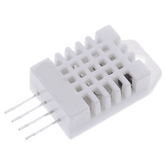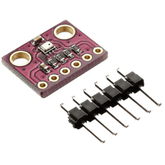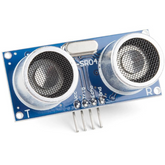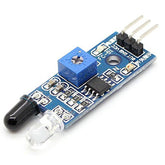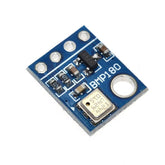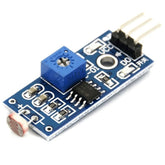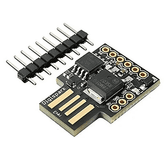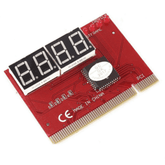How to Choose the Right Sensor for Your Project: A Practical Checklist
Summary
If you're building an electronics project, whether it's a home automation system, a robot, or an IoT device, there's one component that acts as the eyes and ears of your creation: the sensor.
These tiny yet powerful devices gather information from the physical world and convert it into electrical signals that your microcontroller or processor can understand.
But when you walk into any electronics store or browse through an online catalog, you'll be overwhelmed by hundreds of sensor options. Accelerometers, gyroscopes, thermistors, ultrasonic modules, photodiodes: the list goes on. How do you pick the right one?
This guide will walk you through everything you need to know about how to choose the right sensor for your project, from understanding sensor basics to avoiding common pitfalls that even experienced makers encounter.

What Is a Sensor
A sensor is a device that detects changes in its environment and converts those physical phenomena into measurable electrical signals. Think of it as a translator between the physical world and the digital realm of electronics.
When temperature rises, a temperature sensor produces a corresponding voltage change. When an object moves closer, a proximity sensor alters its output signal.
This transformation of physical quantities into electrical data makes automation, monitoring, and intelligent decision-making possible.
There are a wide range of sensors available. Unlike a single-purpose component, sensors come in countless varieties, each designed to detect specific parameters like light intensity, pressure, acceleration, gas concentration, or magnetic fields.
This specificity means that understanding your project's requirements is the first step in sensor selection guide methodology.
So, whether you're monitoring environmental conditions in a greenhouse or building a gesture-controlled robot, there's likely a sensor engineered precisely for that task.
Different Types of Sensors
There are different types of sensors, but most sensors fall into categories based on what they measure and how they communicate data. Understanding types of sensors for electronics projects helps narrow your search significantly.
Active Sensors: Active sensors generate their own energy signal to detect and measure physical phenomena in their environment. Ultrasonic sensors emit sound waves at frequencies above human hearing and measure the time it takes for these waves to reflect back from objects, allowing distance calculation.
Radar sensors transmit electromagnetic waves for long-range detection, while LIDAR systems use laser pulses for precise 3D mapping.
These sensors actively probe their surroundings, making them excellent for applications requiring specific target illumination or distance measurement where ambient conditions may be insufficient for passive detection methods.
Passive Sensors: Passive sensors detect and measure existing energy present in the environment without emitting any signals themselves. Thermistors respond to ambient temperature by changing their electrical resistance, requiring no power output to sense heat.
Photodiodes detect existing light from the sun, lamps, or other sources by converting photons into electrical current. Microphones capture sound waves already present in the air, transforming acoustic pressure into voltage signals.
These sensors excel in low-power applications and situations where adding energy to the environment is undesirable or where detecting naturally occurring phenomena is the goal.
Analog Sensors: Analog sensors produce continuous voltage or current outputs that vary smoothly and proportionally with the measured physical parameter. A thermistor's resistance changes gradually with temperature, producing a continuous range of voltage values when connected in a circuit.
Potentiometers output variable voltages corresponding to rotational position across their full range. These sensors require analog-to-digital converters (ADCs) in the microcontroller for processing, with the ADC resolution determining measurement precision.
Analog sensors often provide high resolution within their operating range and work well for applications requiring smooth, continuous measurement tracking.
Digital Sensors: Digital sensors output discrete values or communicate through standardized digital protocols like I2C, SPI, or UART. The DHT22 temperature sensor sends humidity and temperature data as digital packets over a single-wire interface.
Ultrasonic modules with digital output provide distance measurements as processed numerical values. These sensors often include built-in signal processing, microcontroller compatibility features, and self-contained calibration process capabilities.
This distinction matters tremendously for sensor interfacing. Digital sensors reduce external circuitry requirements, improve noise immunity in electrically noisy environments, and simplify integration with modern embedded systems by eliminating the need for ADC channels and complex analog signal conditioning.
Common Sensor Categories
These are the most common categories of sensors that you will find.
1. Motion detection sensors include multiple technologies for tracking movement and position:

- PIR (Passive Infrared) modules detect human presence by sensing body heat changes
- Accelerometers measure linear acceleration and tilt in one, two, or three axes
- Gyroscopes track rotational velocity for orientation sensing
- Magnetometers detect magnetic field direction for compass applications
- Gesture sensors recognize hand movements using infrared reflection patterns
- Vibration sensors detect mechanical oscillations in machinery monitoring
These are invaluable in security systems, wearable devices, and automation and robotics sensors applications where understanding position and movement drives functionality.
2. Temperature and humidity sensors dominate environmental monitoring with various technologies:

- DHT11/DHT22 provide affordable combined temperature and humidity sensing
- BME280 adds barometric pressure for comprehensive weather stations
- DS18B20 offers waterproof digital temperature sensing with high accuracy
- Thermistors provide simple analog temperature measurement
- Thermocouple handles extreme temperature ranges for industrial applications
- SHT31 delivers precision climate monitoring for laboratory settings
They're essential for weather stations, HVAC control systems, and agricultural applications where real-time data monitoring of climate conditions drives decision-making.
3. Proximity sensors detect nearby objects without physical contact using different principles:

- Ultrasonic sensors measure distance by timing sound wave reflections (2cm to 4m range)
- Infrared proximity sensors work well for short-range detection (2cm to 80cm)
- Capacitive sensors detect both metallic and non-metallic objects through field changes
- Inductive sensors specifically detect metal objects in industrial settings
- Time-of-flight (ToF) sensor uses laser pulses for millimeter-accurate ranging
- Touch sensors enable user interface without mechanical switches
These serve different ranges and materials, making them critical for obstacle avoidance in robotics and touchless interface design.
4. Pressure and force sensors measure mechanical stress across various applications:

- Load cells provide precise weight measurement from grams to tons
- Barometric pressure sensors monitor altitude and weather changes
- Piezoelectric sensors detect rapid pressure changes and vibrations
- Strain gauges measure deformation in structural monitoring
- Force-sensitive resistors (FSR) offer simple touch pressure detection
- Differential pressure sensors monitor flow and filter conditions
From delicate touch inputs on electronic scales to industrial applications monitoring hydraulic systems, these sensors transform physical force into measurable electrical signals.
5. Light and sound sensors capture environmental conditions for diverse applications:

- Photodiodes provide fast, accurate light intensity measurement
- Light-dependent resistors (LDRs) offer simple analog light sensing
- RGB color sensors detect and differentiate colors
- UV sensors monitor ultraviolet radiation levels
- MEMS microphones capture sound with flat frequency response
- Sound level sensors measure ambient noise for environmental monitoring
- Infrared receivers enable remote control communication
They're perfect for photography automation, solar trackers, voice-activated systems, and noise monitoring, offering varying sensitivity and frequency response characteristics.
Understanding sensor types and applications helps you match the sensor category to your project's core function before diving into specific model selection.
Key Factors to Consider Before Choosing a Sensor
Selecting a sensor is about ensuring it integrates seamlessly with your system while meeting performance, budget, and environmental requirements. These factors to consider before buying a sensor will save you countless hours of troubleshooting.
Measurement Range and Sensitivity
Define the minimum and maximum values your sensor must detect:
- Identify the expected range of values in your application
- Add safety margins beyond typical operating conditions
- Verify sensor sensitivity can detect the smallest required changes
- Consider whether resolution meets your precision needs
A temperature sensor measuring room comfort needs a different range than one monitoring furnace temperatures. Sensitivity determines the smallest change the sensor can reliably detect, which is critical for applications requiring precise data acquisition and accuracy.
Accuracy and Precision
Accuracy refers to how close sensor readings are to true values, while precision indicates repeatability:
- Check manufacturer accuracy specifications at operating temperature
- Understand if stated accuracy includes or excludes calibration
- Evaluate whether drift over time affects long-term performance
- Determine if the calibration process is feasible for your application
Medical devices demand high accuracy, while hobby projects may tolerate greater margins. Understanding specifications prevents the common mistakes in sensor selection where makers choose sensors insufficient for their precision needs.
Operating Environment
Environmental conditions for sensors dramatically affect performance and longevity:
- Temperature extremes: Verify sensor operates across expected thermal range
- Humidity exposure: Choose moisture-resistant variants for wet environments
- Dust and particulates: Consider sealed or filtered sensor housings
- Vibration and shock: Select ruggedized sensors for mobile applications
- Chemical exposure: Ensure sensor materials resist corrosive substances
- Electromagnetic interference: Check EMI/RFI immunity for noisy environments
An environment-based sensor choice might mean selecting an IP67-rated sensor for outdoor applications or a high-temperature variant for automotive projects. This factor alone determines sensor reliability and lifespan.
Power Consumption
Battery-powered and IoT projects require careful attention to sensor power draw:
- Compare typical operating current versus sleep mode consumption
- Calculate expected battery life based on sampling frequency
- Evaluate whether the sensor supports duty cycling or triggered operation
- Consider overall system power budget with all components active
Low-power sleep modes, duty cycling, and choosing energy-efficient sensors extend operational time. Some wireless and wired sensors consume orders of magnitude more power than alternatives measuring the same parameter.
Response Time
How quickly must your sensor react:
- Determine required update rate for your control loop
- Check sensor warm-up time requirements
- Verify settling time after power-on or mode changes
- Consider data filtering effects on effective response
Industrial sensor selection for safety applications demands millisecond response times, while environmental monitoring can tolerate seconds or minutes. Response time affects sensor performance testing outcomes and real-world functionality.
Output Type and Interface
The sensor's input and output signals must match your processing hardware:
- Analog output: Requires ADC channels with appropriate resolution and voltage range
- Digital protocols: Verify I2C, SPI, UART, or other interface availability
- Microcontroller compatibility: Check voltage level compatibility (3.3V vs 5V logic)
- Pin requirements: Ensure sufficient GPIO pins remain for other functions
- Software libraries: Confirm driver availability for your development platform
Modern embedded systems often prefer digital interfaces for simplified integration, but analog sensors sometimes offer superior resolution.
Physical Size and Mounting
Physical constraints matter in compact designs:
- Measure available space in your enclosure before ordering
- Consider breakout board size versus bare sensor dimensions
- Evaluate mounting hole patterns and hardware requirements
- Check connector types and cable lengths needed
- Determine if sensor orientation affects measurement accuracy
Breakout boards simplify prototyping but may be too large for finished products.
Cost and Availability
Budget influences every project:
- Compare sensor prices across suppliers for volume discounts
- Evaluate total system cost including required support components
- Check lead times and stock availability for your timeline
- Consider whether cheaper alternatives sacrifice critical specifications
- Verify manufacturer continues producing the sensor long-term
Premium sensors offer better specifications but may be overkill for basic applications. Supply chain considerations matter too—choosing widely available sensors from reputable suppliers ensures you can source replacements and scale production.
Sensor Selection Checklist
Before committing to a sensor purchase, work through this practical sensor buying guide checklist to validate your choice:
Define Project Requirements
- What physical parameter needs measurement?
- What measurement range and accuracy are required?
- How frequently will readings be taken?
- Is real-time response critical or can processing be delayed?
Technical Specifications
- Does the sensor's range cover your expected values with margin?
- Is the accuracy specification adequate for your application?
- Can the sensor operate in your project's environmental conditions?
- Does response time meet your real-time processing needs?
- What is the expected sensor lifetime and replacement cost?
Interface Compatibility
- What output interface does the sensor provide (analog, I2C, SPI, UART)?
- Does your microcontroller support this interface natively?
- Are voltage levels compatible (3.3V vs 5V logic)?
- How many GPIO pins does the sensor require?
- Are level shifters or additional components needed?
Power Requirements
- What is the sensor's typical and maximum current draw?
- Does it have low-power or sleep modes for battery operation?
- Can your power supply provide sufficient current for all components?
- What voltage regulation is needed?
Physical Integration
- Will the sensor fit in your enclosure?
- What mounting options are available?
- Does it require specific orientation or positioning?
- What cable length is needed between sensor and controller?
Data Processing
- Does the sensor require complex signal processing or filtering?
- Is sensor datasheet interpretation straightforward with clear examples?
- Are libraries available for your development platform?
- What considerations exist for signal noise and interference mitigation?
- How will you handle outlier readings or sensor errors?
Testing and Validation
- Can you prototype with a breakout board before production?
- Is sample data available showing typical performance?
- Are there user reviews or community projects using this sensor?
- What test equipment do you need to validate sensor accuracy?
Long-term Considerations
- What is the sensor's expected operational lifetime?
- Is calibration required, and if so, how frequently?
- Are replacement parts readily available?
- Does the manufacturer provide adequate documentation and support?
- Can you source the sensor from multiple suppliers?
This systematic approach to how to select a sensor for your project eliminates guesswork and reduces expensive mistakes.
Best Sensors for Popular Electronics Projects
At Robocraze, we've helped thousands of makers bring their ideas to life, and we've learned which sensors consistently deliver exceptional results across common project types.
Through years of supporting hobbyists, students, and professional developers, we've identified patterns in what works reliably and what causes headaches down the line.
The sensors we recommend are proven in real-world applications with strong community support, readily available documentation, and consistent quality that removes uncertainty from your build process.
Conclusion
Choosing the right sensor transforms projects from frustrating experiments into reliable, functional systems.
By understanding sensor fundamentals, evaluating your specific requirements systematically, and following a comprehensive selection checklist, you eliminate the guesswork that trips up many makers.
Remember that a lot of factors, such as environmental factors, interface compatibility, and practical integration challenges all play crucial roles in success.



